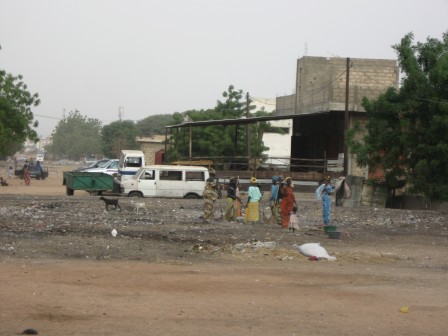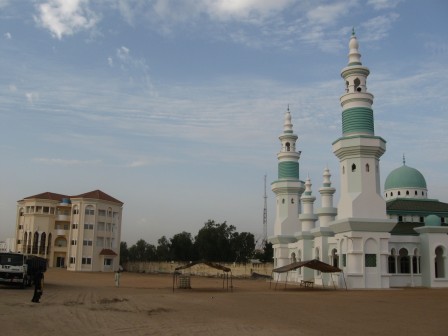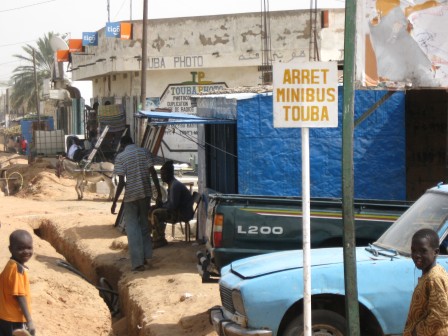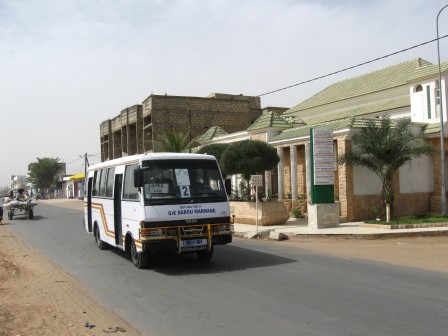The other day Esperance showed up over an hour late which is not normal. And when we asked her if she was okay - she said yes with a heavy sigh - as she was still trying to catch her breath from walking the last leg to our house from wherever she was dropped off about 3km -5km away. I wasn't clear on the transport mechanism or the actual spot but she ended up at - but what I did get is that she tried very had to make sure she showed up to work. And the reason for her delay we learned from her was that Muslims were heading out on a pilgrimage to Touba - 207km east of Dakar and there was no available transport as they were packed to the gills (car-rapides, white-mini buses, motor-cycles, trucks, sept-places even horse and cart) going of course in the opposite direction she needed to go. Today she called (because this time we made sure she had our number) and told us it wasn't possible to get to our house. Even more people headed to Touba - she's hoping she will be able to get here tomorrow since she is obviously not taking the pilgrimage.

So what's happening this week - The Grand Magal (marks the 48 days after the Islamic New Year) - an important annual pilgrimage for Muslims and especially, the Mourides, a sect of Islam - the most popular and most numerous in Senegal. This pilgrimage culminates in prayer and celebration on Thursday, January 12th. In fact, Magal is a word in Wolof that means "to pay tribute" or "to celebrate." - and therefore honoring the memory of Sheikh Amadou Bamba
So what's happening this week - The Grand Magal (marks the 48 days after the Islamic New Year) - an important annual pilgrimage for Muslims and especially, the Mourides, a sect of Islam - the most popular and most numerous in Senegal. This pilgrimage culminates in prayer and celebration on Thursday, January 12th. In fact, Magal is a word in Wolof that means "to pay tribute" or "to celebrate." - and therefore honoring the memory of Sheikh Amadou Bamba
A little history from Wikipedia...
As the founder of Mouridism, Cheikh Ahmadou Bamba is considered one of the greatest spiritual leaders in Senegalese history. Mouridism is today one of Senegal’s four Sufi movements, with four million devotees in Senegal alone and thousands more abroad majority of who are emigrants from Senegal. Followers of the Mouridism movement, an offshoot of traditional Sufi philosophy, aspire to live closer to God, in emulation of the Prophet Muhammad's example. Amadou Bamba's teachings emphasized the virtues of pacifism and the importance of hard work, became in the 20th century one of the biggest influences on contemporary Senegalese life and culture.As an ascetic marabout who wrote tracts on meditation, rituals, work, and Qur'anic study, he is perhaps best known for his emphasis on work, and his disciples are known for their industriousness.
In the political sphere, Ahmadou Bamba led a pacifist struggle against French colonialism while trying to restore a purer practice of Islam insulated from French colonial influence. In a period when successful armed resistance was impossible, Cheikh Ahmadou Bamba led a spiritual struggle against colonial culture and politics. Although he did not wage outright war on them as several prominent Tijaan marabouts had done, he taught what he called the jihād al-'akbar or "greater struggle," which fought not through weapons but through learning and fear of God.
As his fame spread, the French colonial government worried about Bamba's growing power and potential to wage war against them. He had converted a number of traditional kings and their followers and no doubt could have raised a huge military force, as Muslim leaders like Umar Tall and Samoy Tore had before him.
The French sentenced him to exile in Gabon(1895–1902) and later in Mauritania (1903–1907). However, these exiles fired stories and folk tales of Bamba's miraculous survival of torture, deprivation, and attempted executions, and thousands more flocked to his organization. On the ship to Gabon, forbidden from praying, Bamba is said to have broken his leg-irons, leapt overboard into the ocean and prayed on a prayer rug that appeared on the surface of the water, so devout was he. Or, when the French put him in a furnace, he simply sat down in it and drank tea with Muhammad. In a den of hungry lions, the lions slept beside him, etc.
By 1910, the French realized that Bamba was not interested in waging war against them, and was in fact quite cooperative, eventually releasing him to return to his expanded community. In 1918, he won the French Legion of Honor for enlisting his followers in the First World War and the French allowed him to establish his community in Touba, believing in part that his doctrine of hard work could be made to serve French economic interests. His movement was allowed to grow, and in 1926 he began work for the great mosque at Touba where he is buried. He died in 1927.
. ********************
On another note - I found this posting on the web (I added below) by Eric Ross who is a Associate Professor of Geography at Al Akhawayn University in Ifrane, Morocco - he posted it on- Jan 9, 2012- so it's very fresh and informative.
A link to Eric' Ross''s website http://ericrossacademic.wordpress.com/about/
Being in Touba in the weeks leading up to the Grand Magal allowed me, for the first time, to observe how the city is readied for the event. Given the general low level of mechanization, much of the work is labor intensive. Taalibes and Baye Fall, women as well as men, contribute to the effort with great enthusiasm.

A group of women sweep up after a pile of rubbish has been removed from a street in their neighborhood. (ph. Eric Ross)
First, there is the physical clean up of the city. Mounds of garbage that have accumulated on certain streets and in empty lots are loaded onto trucks and taken to dumps outside the city. Much of the rest of the work is less visible, but it relates to both public spaces as well as private homes.
Public health is a major issue during the Grand Magal as the city of about 600 000 inhabitants swells with well over a million pilgrims. Cholera in particular is of major concern. Past Magals have experienced serious outbreaks of the disease—incidents of cholera were already being recorded in the area around Touba two weeks prior to this year’s event. The Ministry of Health works closely with Murid officials to implement preventative measures. One of these measures consists of emptying all the city’s septic tanks prior to the arrival of pilgrims. Touba has no sewers. Houses are equipped with septic tanks instead. Though, as it is destined to continue to grow, Touba will eventually have to install sewer mains, the septic tank system works fairly well in normal times. The soil beneath the city is very sandy and therefore quite permeable. However, having upwards of two million people generate liquid waste over a period of a few days stretches this system beyond its limits. All the tanks are therefore emptied in advance to create the necessary capacity (I will spare readers of the blog post pictures of this particular activity). Moreover, rows of mobile toilet booths are set up near the main shrines, where crowds are greatest during the Magal.
The provision of clean safe drinking water is the second pillar of the cholera prevention strategy. Touba’s water distribution network is barely sufficient to cover ordinary needs. Water pressure in the mains is very low. In order for water to reach the upper floors of buildings, it has to either be pumped up (electric or diesel pumps) or carried up in buckets (girls are assigned this heavy work). During the Grand Magal the city’s water pipes simply run dry most of the day. Houses are therefore equipped with reservoirs (concrete chambers in the basement or plastic containers on the roof). All of these need to be filled prior to the Magal. And before this is done they are all emptied and disinfected. Again, all this work is done by hand. Furthermore, large plastic water reservoirs, replenished by tanker trucks, are set up at many points near the main shrines and along the main thoroughfares.

A plastic reservoir on the roof of this house provides its residents with a reliable supply of water. Other elements of roofscapes common across the continent include cellular telephone towers and satellite TV dishes. (ph. Eric Ross)
Another aspect of preparation for the Grand Magal, though less official in nature, is the rush to complete construction projects. Many houses in Touba are more-or-less in a perpetual state of construction. People add rooms and floors to their houses as finances allow, and as families grow in size. There are no hotels or hostels in Touba. During the Grand Magal, most pilgrims stay with family members who live in the holy city, though many wealthier Murids who live elsewhere build a second home in Touba especially for this purpose. Every available bed, sofa, foam mattress and plastic floor mat is needed. Tents are erected in courtyards and in the streets to accommodate the overflow from houses. Home-owners are therefore anxious to complete any on-going construction ahead of the Magal. Masons, plumbers and electricians are in high demand. Many come from other cities to work in Touba a month or so prior to the event.

These construction workers added a floor to this house in just one month, working almost around the clock. The new rooms will not however be ready in time for the Grand Magal. (ph. Eric Ross)
There is an official side to the Grand Magal which cannot be ignored. Hundreds of dignitaries are invited to the event. These include: representatives of other Sufi orders from across Senegal and Mauritania, government officials, senior civil servants, politicians and representatives of political parties (presidential elections are scheduled for February 2012), as well as ambassadors from numerous Muslim countries. They all have to be hosted by the Khalif-General. The Kër Sëriñ Touba facing the Great Mosque, erected in the 1970s especially for this purpose, is now far too small to accommodate all these guests. A new Kër Sëriñ Touba is currently being built in Darou Marnane, at the main entrance to the city, parts of which may be completed in time for this year’s Grand Magal.

Construction of the new Kër Sëriñ Touba in Darou Marnane nears completion. The Mosque has received its first coat of paint. The four-story residential building to the left looks like it may be ready in time for pilrims. (ph. Eric Ross)
As you might expect, many hundreds of thousands of motor vehicles flooding into the city from elsewhere creates something of a traffic problem. Touba’s urban planners have always taken the Grand Magal into account, and even at the height of the Grand Magal the traffic in Touba is nowhere nearly as congested as it is on even an ordinary day in Dakar. Nonetheless, efforts are still being made to improve the holy city’s street network. Many secondary streets have been paved over the past four years, a policy initiated by El-Hadj Bara Mbacké during his brief caliphate.
Also, and importantly, Touba now has a public transit system. Tata minibuses (of Indian manufacture) now ply the city’s main avenues, stopping at designated bus stops.
Most passenger transportation however still relies on taxis (more expensive), private back-loading minibuses (less expensive), and donkey carts (cheapest of all).
I will not actually be in Touba the day of the Grand Magal (18 Safar=12 January) as I have to return to Morocco. I wish everyone a successful event, after all this hard work!

The mosque in Gouye Mbinde neighborhood is festively decorated with strings of colored lights ahead of the Grand Magal. (ph. Eric Ross)




Thank you very much for relating your experience at the Dakar end of the Magal. It is in fact a national--and an international--event. No matter where you are in Senegal, there is no avoiding it.
ReplyDeleteThis was a wonderful post!
ReplyDelete